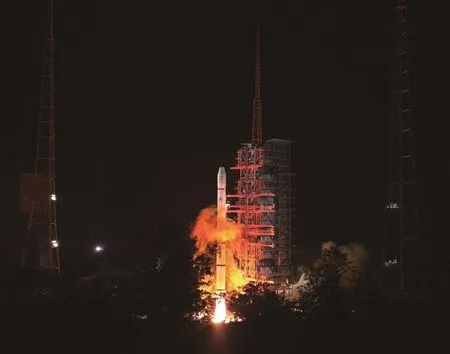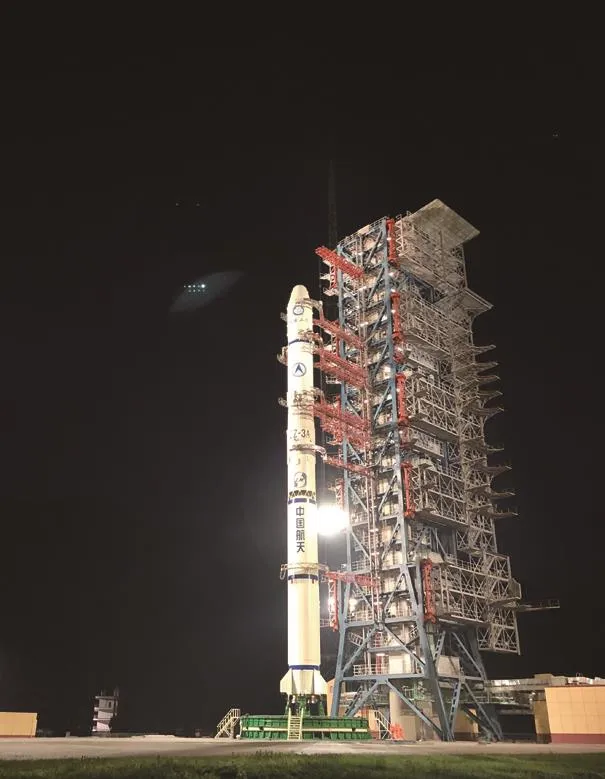Last FY-2 Series Satellite Successfully Launched on A LM-3A
2018-02-20WEIJinghua,ZHAOCong,ZHANGBo
A LM-3A launch vehicle lifted off from the Xichang Satellite Launch Center at 21:07 Beijing time on June 5, launching the FY-2H satellite into orbit. This was the 277th flight mission of the LM family launch vehicle.
FY-2H was the last flight unit of the FY-2 series satellite, China’s first generation geostationary meteorological satellite. It was developed by the Shanghai Institute of Satellite Engineering of the Shanghai Academy of Spaceflight Technology (SAST), which commenced in September 2015.
The FY-2H satellite is spin-stabilized and is capable of obtaining visible and infrared cloud images and measuring the distribution of water vapor, collecting and transferring environmental monitoring data related to meteorology, oceans and hydrology as well as broadcasting stretched digital images and monitoring closely changes in weather systems with different temporal and spatial scales.
FY-2H operates in geosynchronous orbit at 36000 km above the Earth. The primary payloads which are carried are a Stretched Visible and Infrared Spin Scan Radiometer (S-VISSR)and a Space Environment Monitor (SEM), which provide realtime visible, infrared and water vapor images, products related to space weather and space environment measurements at the altitude of the satellite.

FY-2H is flying aboard a LM-3A launch vehicle
The S-VISSR has 1 visible and 4 infrared channels, which are capable of obtaining a full disk image covering 1/3 of the Earth surface every 1 hour in non-flood season and every half an hour in flood season. It focuses on disastrous weather systems such as those of typhoons and severe convective weather, playing an important role in monitoring and early warning for weather disasters thus helping with disaster avoidance and mitigation.
The SEM is able to measure solar X-ray, high-energy proton, electron and HZE fluxes for space weather monitoring,forecast and early warning.

A LM-3A launch vehicle is waiting for launch

The FY-2H satellite during illumination test
After in-orbit commissioning, FY-2H will adjust its orbit and be positioned at 79°E. It will perform networking observation together with the in-orbit FY-2E, FY-2F and FY-2G, which is of great significance in ensuring the operational continuity between the two generations of geostationary meteorological satellites in China, helping improve China’s ability for weather system upstream observations. Before the in-orbit networking operation of FY-4 satellites, the FY-2 series satellite will continue to provide meteorological support, supplying China and countries along the Belt and Road Initiative and APSCO member states with services like weather forecast and monitoring for disaster risk reduction and mitigation, contributing more to the community with a shared future for mankind.
China began to develop the FY-2 satellite series in 1986.From 1997 till now, a total of 8 FY-2 satellites have been launched successfully, 4 are functioning in orbit currently. They are functioning in a dual-satellite mode, providing mutual backups in orbit and intensifying observation as needed. They provide China and surrounding areas with real-time and dynamic meteorological observation data for weather forecasts.
The FY-2 series satellite has monitored 471 typhoons generated in the Western Pacific Ocean and the South China Sea and 141 typhoons which landed in China since its operation started in 1998 (as of the fifth typhoon this year) with no escape.
China is one of the few countries operating both polarorbiting and geostationary meteorological satellites. After nearly 50 years’ development, China has successfully launched 8 polar-orbiting and 9 geostationary meteorological satellites. The following 8 satellites are currently in service: FY-2E, FY-2F, FY-2G and FY-2H, FY-3B, FY-3C, FY-3D and FY-4A.
From May 1, the FY-4A satellite has been put officially into operation, providing customers both at home and abroad with data and products. FY-4A carries high orbit observation instruments, which are the first of their kind in the world.
FY series of meteorological satellites have reached an advanced international level and have been incorporated into the global constellation of operational meteorological satellites within the World Meteorological Organization (WMO) framework, becoming an important member of the Integrated Global Observing Strategy (IGOS). They are also part of the on-duty satellites of the International Charter Space and Major Disasters,supplying customers in over 80 countries and regions and 2500 domestic users with satellite data and products.
杂志排行
Aerospace China的其它文章
- Intelligent and Autonomous Flight Technology for Launch Vehicles
- LM-11— The Main Force in China’s Small Launch Vehicles for Commercial Launch
- LM-11SL: A Sea-Launched Carrier Rocket for Small Satellites and Its Launch Service
- QB50 Project and the Development of CubeSat Technology in China
- CAASSE Signed a MOU with HASSE
- Welcome to the First China International Symposium on Microsatellite
